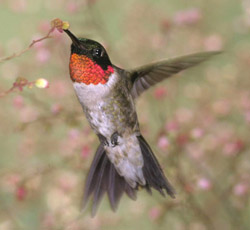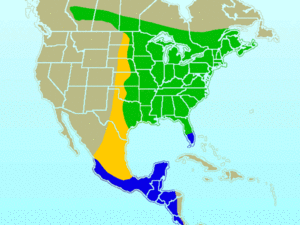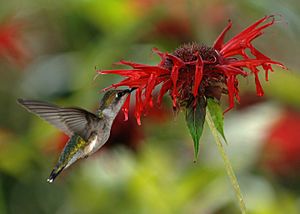Ruby-throated hummingbird facts for kids
Quick facts for kids Ruby-throated hummingbird |
|
|---|---|
 |
|
| Conservation status | |
| Scientific classification | |
| Genus: |
Archilochus
|
| Species: |
colubris
|
 |
|
| Summer-only range Winter-only range Migratory path | |
| Synonyms | |
|
Trochilus colubris Linnaeus, 1758 |
|
The ruby-throated hummingbird (Archilochus colubris) is a small, colorful bird. It spends winters in warmer places like Central America, Mexico, and Florida. When summer arrives, it flies north to Canada and other parts of Eastern North America to have its babies. This hummingbird is the most common one you'll see east of the Mississippi River in North America.
Contents
About the Ruby-throated Hummingbird
The ruby-throated hummingbird was first officially described in 1758. This was done by a Swedish scientist named Carl Linnaeus. He gave it the scientific name Trochilus colubris. Later, it was placed in the group (genus) called Archilochus. The word colubris comes from a Spanish word for hummingbird, colibrí. This type of hummingbird is a single species, meaning there are no different kinds (subspecies) of it.
What Ruby-throated Hummingbirds Look Like
These hummingbirds are small, usually about 7 to 9 centimeters (3 to 3.5 inches) long. Their wings can spread out 8 to 11 centimeters (3 to 4 inches). They are very light, weighing only 2 to 6 grams (0.07 to 0.2 ounces). Males are a bit lighter than females.
Their bodies are metallic green on top and grayish-white underneath. Their wings are almost black. They have a long, thin, straight bill that can be up to 2 centimeters (0.8 inches) long. Their feet are tiny, so they can only shuffle along a branch.
Male vs. Female
Male and female ruby-throated hummingbirds look different. This is called sexual dimorphism.
- The adult male has a bright, shiny ruby-red patch on his throat. This patch looks black from some angles. He also has a black, forked tail.
- The female has a white throat, sometimes with a few dark spots. Her tail is notched and has green, black, and white bands.
- Young males look a lot like adult females, but they might have more throat markings.
These birds change their feathers once a year. This happens in their winter homes, starting in early fall and finishing by late winter.
Hummingbird Sounds
Ruby-throated hummingbirds make quick, squeaky chirps. They use these sounds mostly to warn others. For example, a male might chirp to tell another male to stay out of his area.
During their courtship dances, males make a fast tik-tik tik-tik tik-tik sound with their wings. This sound happens when they fly side-to-side or dive. Sometimes, they also make a soft, repeated whining sound with their tail feathers during a dive. They spread and close their tail as they fly over the female.
Where Ruby-throated Hummingbirds Live
These hummingbirds build their nests in forests, gardens, and orchards. They like areas with both leafy and pine trees. You can find them breeding across most of the Eastern United States and parts of southern Canada. Of all hummingbirds in the U.S., they have the biggest area where they raise their young.
Ruby-throated hummingbirds are migratory birds. This means they travel long distances between seasons. They spend most of the winter in Florida, southern Mexico, and Central America. Some even go as far south as Panama and the West Indies.
During their journey, some birds fly 900 miles (1,450 kilometers) non-stop. They cross the Gulf of Mexico and Caribbean Sea to reach the eastern United States. Older birds are usually better prepared for this long flight. They have more body weight and fat to use as fuel.
How Ruby-throated Hummingbirds Behave
Ruby-throated hummingbirds are usually alone. Adults don't spend time together, except for a few minutes during mating. The female then takes care of the babies by herself. Both males and females are very protective of their space. They will attack and chase away other hummingbirds that come into their feeding areas.
Amazing Flights
In spring, many hummingbirds fly from the Yucatán Peninsula in Mexico across the Gulf of Mexico. This is an amazing trip because it's about 800 kilometers (500 miles) over water with no stops. A hummingbird weighs only about 3 grams (0.1 ounces). How can they fly so far? Scientists found that these tiny birds can double their body fat before the trip. They use all this fat as energy during the 20-hour flight when there's no food or water.
Hummingbirds have one of the fastest body processes of any animal. Their hearts can beat up to 1260 times per minute. They breathe about 250 times per minute, even when resting. When they fly, their muscles use about 10 times more oxygen than a human athlete's muscles.
They eat often during the day. When it gets cold, especially at night, they can save energy. They do this by going into a deep sleep-like state called torpor. This lowers their body temperature and slows down their heart rate.
How They Fly
Hummingbirds have special bones and muscles that help them fly so well. Their flight muscles make up 25–30% of their body weight. Their wings are long and shaped like blades. Unlike other birds, their wings connect to their body only at the shoulder. This lets them spin their wings almost all the way around. This is why they can fly forward, backward, and even hover in one spot. This is very rare for birds, but common for insects.
Their main wing bone, the humerus, is perfect for hovering. Hummingbirds have a short humerus bone. They also have very strong chest muscles. These muscles help them twist their wings during the upstroke when they hover.
Hummingbirds can hover because they are light, flap their wings very fast, and have a lot of power for their size. Their strong flight muscles and wing shape help them keep their wings extended but turned over during the upstroke. This creates lift, helping them stay in the air.
When hovering, a hummingbird's wings beat up to 80 times per second! They get lift from both the downstroke (about 75%) and the upstroke (about 25%) of their wings. This is similar to how insects fly.
What Ruby-throated Hummingbirds Eat

Their main food is nectar from flowers and flowering trees. They also eat small insects and spiders. While nectar gives them energy, insects are very important. They provide protein, minerals, and vitamins that adult hummingbirds need.
Hummingbirds like red, orange, and bright pink tubular flowers best. However, they will also visit other flowers. Sometimes, they drink sweet sap from holes made by sapsucker birds in trees. They use their long, stretchy tongue to get nectar from flowers. They catch insects while flying or pick them off flowers, leaves, and spiderwebs.
Young hummingbirds are fed mostly insects. This is because nectar doesn't have enough protein for them to grow strong.
Reproduction and Life Cycle
Ruby-throated hummingbirds don't form pairs for life. The male leaves right after mating. The female builds the nest and takes care of the eggs and young all by herself.
Males arrive at the breeding areas in spring before the females. They set up a territory. When females arrive, males try to attract them with special dances. They perform a "dive display," flying high up (2.45 to 3.1 meters or 8 to 10 feet) and then swooping down. If the female lands, the male flies in very fast, small arcs in front of her. If she likes him, she might make a sound and get into a special pose with her tail up and wings down.
The female usually builds her nest on a small, sloped tree branch. It's often 3.1 to 12.2 meters (10 to 40 feet) above the ground. They prefer trees like oak, birch, or poplar, but sometimes use pine trees. Nests have even been found on chains or wires!
The nest is made of tiny plant parts, like bud scales. The outside is covered with lichen, held together with spider silk. The inside is soft, lined with plant fluff (like dandelion or thistle down) and animal hair. Most nests are very hard to see. Old nests can be used again for several years, but the female repairs them each year.
Females lay two (sometimes one or three) tiny white eggs. They are about 12.9 by 8.5 millimeters (0.5 by 0.3 inches) in size. They can have one or two groups of babies each summer. The female sits on the eggs for 12 to 14 days until they hatch. The chicks are born without feathers but quickly grow them.
The female feeds the chicks by bringing up food from her stomach. She does this 1 to 3 times every hour, often while hovering. When the young birds are 18 to 22 days old, they leave the nest and take their first flight.
How Long Ruby-throated Hummingbirds Live
The oldest known ruby-throated hummingbird lived for 9 years and 1 month. Most hummingbirds that live 7 years or more are females. Males rarely live past 5 years. This might be because males lose a lot of weight during breeding season from defending their territory. This makes their long migration even harder.
Many animals try to catch hummingbirds. Because they are so small, even birds that usually eat insects can be a danger. However, adult hummingbirds are very fast and quick. This makes them hard for most predators to catch.
Some of their main predators are smaller, fast raptors like sharp-shinned hawks and merlins. Domestic cats, loggerhead shrikes, and even greater roadrunners also hunt them. These predators often try to surprise the hummingbird when it's resting, sleeping, or busy eating or breeding.
Lizards and snakes that eat birds can also hunt them, especially in their warm winter homes. Even large insects can be predators! Praying mantises have been seen catching adult hummingbirds at feeders. Large spiders and dragonflies can also be a threat. Blue jays and other birds like crows, bats, squirrels, and chipmunks often prey on hummingbird nests.
Gallery
-
Female ruby-throated hummingbird, North Carolina
-
Male ruby-throated hummingbird perched on a branch, displaying its tongue, East Texas
See also
 In Spanish: Colibrí gorgirrubí para niños
In Spanish: Colibrí gorgirrubí para niños








